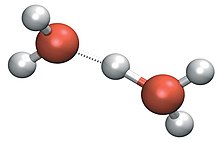Georg Zundel
This article includes a list of references, related reading or external links, but its sources remain unclear because it lacks inline citations. (February 2013) |
Georg Zundel | |
|---|---|
 Georg Zundel | |
| Born | May 17, 1931 |
| Died | March 11, 2007 (aged 75) |
| Nationality | German |
| Alma mater | University of Munich |
| Known for | Zundel cation |
| Scientific career | |
| Fields | physical chemistry |
| Institutions | University of Munich |
Georg Zundel (May 17, 1931 – March 11, 2007) was a German physical chemist, tenured professor of biophysics at University of Munich, peace activist, environmentalist and philanthropist.
His father Georg was a painter and his mother was the daughter of the German industrialist Robert Bosch.
As a scientist, a physicist, he achieved a worldwide reputation for hydrogen bond research. He worked closely with colleagues from both the East and the West during the Cold War. He published 313 scientific papers during his academic career. A number of scientific discoveries in the area of hydrogen bonds carry Zundel's name, most notably:

- the Zundel cation (H5O2+) which is an important structure for the solvated hydrogen ion in water
- , the property of hydrogen bonds to have hydrogen protons shifted by means of an electric field
- , the property of hydrogen bonds to absorb a wide range of ions
As an entrepreneur he founded the Berghof Laboratory of Physics and Technology in 1966, re-organised in 2003 as Zundel Holding GmbH + Co with four companies in different locations throughout Germany, active in the automation and environmental sectors.
As a philanthropist he established the in 1971, which soon came to play a defining role in the then-emerging field of peace research. The Foundation's main establishments are:
- , BCR (formerly: Berghof Research Center for Constructive Conflict Management, BRC), established 1993, since 1977 in partnership with the /
- , BPS (Berghof Foundation for Peace Support, BFPS), established 2004.
In this area, he was awarded the Great Cross of Merit of the Federal Republic of Germany, in 2003.
References[]
- Autobiography: „Es muss viel geschehen!“ Berlin, Verlag für Wissenschafts- und Regionalgeschichte Dr. Michael Engel, 2006.
External links[]
- zundel.at – website on Georg Zundel, by his son/s
- berghof-foundation.de – Berghof Foundation for Conflict Studies, BFCS
- berghof-conflictresearch.org (berghof-center.org) – Berghof Conflict Research, BCR (formerly: Berghof Research Center for Constructive Conflict Management, BRC)
- berghof-peacesupport.org – Berghof Peace Support, BPS (Berghof Foundation for Peace Support, BFPS)
- berghof.com – Berghof Group / Zundel Holding
- 1931 births
- 2007 deaths
- German physical chemists
- Commanders Crosses of the Order of Merit of the Federal Republic of Germany
- German chemist stubs
- German physicist stubs